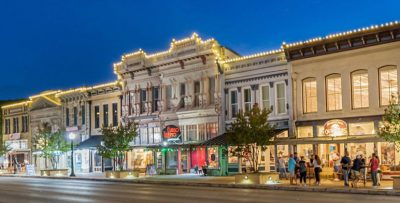
8 of 10 Largest U.S. Cities Lose Population; Sun Belt Grows

Georgetown, Texas, is the fastest-growing city in the U.S., according to the Census Bureau (photo courtesy Georgetown Convention & Visitors Bureau).
Sun Belt cities have benefited from U.S. population shifts over the past several decades, the Census Bureau reported this month; new data show the top 15 fastest-growing U.S. cities are entirely in the South and West.
Meanwhile, urban areas continue to face fallout from pandemic-induced trends, with eight of the 10 largest American cities reporting substantial population drops, Census said.
The data show eight of the 15 fastest-growing large cities or towns by percent change were in the West — with five in Arizona — and seven in the South. The South and West also contained the top 15 cities with the largest numeric gains — 11 in the South and four in the West.
“While only 4% of all cities and towns had a population of 50,000 or more in 2021, collectively they contained 129.3 million people — nearly 39% of the U.S. population,” said Crystal Delbé, a statistician in the Population Division at the Census Bureau. “On the other hand, of the 19,494 incorporated places in the United States, more than 75% had fewer than 5,000 people.”
Georgetown, Texas, had the largest growth from July 2020 to July 2021, increasing by 10.5%, a rate of growth that would double the population in less than seven years. Georgetown was followed by Leander, Texas (10.1%); Queen Creek Town, Ariz. (8.9%); Buckeye, Ariz. (8.6%); and New Braunfels, Texas (8.3%).
The sixth-fastest-growing area was Fort Myers, Fla. (6.8%), followed by Casa Grande, Ariz. (6.2%); Maricopa, Ariz. (6.1%); North Port, Fla. (5.5%); Spring Hill, Tenn. (5.4%); Goodyear, Ariz. (5.4%); and Port St. Lucie, Fla. (5.2%). Rounding out the list were three suburbs of Boise, Idaho: Meridian (5.2%), Caldwell (5.2%) and Nampa (5.0%).
San Antonio, Texas, topped the list of the largest numeric gainers with an increase of 13,626 people between 2020 and 2021, followed by Phoenix (13,224); Fort Worth, Texas (12,916); Port St. Lucie (10,771); North Las Vegas, Nev. (9,917); Cape Coral, Fla. (8,220); Buckeye (8,001); Frisco, Texas (7,933); New Braunfels (7,538); Georgetown (7,193); Meridian (6,234); Leander (6,159); Fort Meyers (5,891); Denton, Texas (5,844); and McKinney, Texas (5,568).
The top 15 largest cities remained the same as in 202, although more than half experienced decreases in their population between 2020 and 2021: New York (-305,465); Los Angeles (-40,537); Chicago (-45,175); Houston (-11,777); Philadelphia (-24,754); San Diego (-3,783); Dallas (-14,777); San Jose, Calif. (-27,419); and Indianapolis (-5,343). Notably, San Francisco, which ranks outside the top 15, lost nearly 55,000 residents during the period—6.3 percent of its population, the highest percentage of any U.S. city.
Despite decreasing in population, New York remained the nation’s largest city. Its July 1, 2021, population of 8.5 million was more than twice that of the next largest city, Los Angeles, with a population of nearly 4 million, followed by Chicago (2.7 million); Houston (2.3 million); Phoenix (1.6 million); Philadelphia (1.6 million); San Antonio (1.5 million); San Diego (1.4 million); Dallas (1.3 million); and San Jose (1.0 million).
The report noted the nation’s housing stock grew by 1.3 million units between July 2020 and July 2021, reaching a total of 142.2 million. The annual growth rate of 1.0% from 2020 to 2021 increased slightly from 0.8% between 2019-2020.
California had the largest number of housing units (14.5 million) on July 1, 2021, followed by Texas (11.9 million) and Florida (10.1 million). The states with the fewest housing units were Wyoming (274,400) and Alaska (327,900). Utah experienced the nation’s fastest growth in housing units, with an increase of 2.7 percent between July 1, 2020, and July 1, 2021, followed by Idaho (2.5%) and Texas (2.0%).
The states with the slowest housing growth were Rhode Island (0.2%), Illinois (0.2%) and West Virginia (0.3%).
The fastest-growing county was Rockwall County, Texas, which increased by 6.5% between July 1, 2020, and July 1, 2021, followed by Chambers County, Texas (5.7%); Jasper County, S.C. (5.4%); Hays and Comal counties in Texas, and Morgan County, Ga. (5.2%) were tied for third, followed by Fort Bend County (5.1%); and Long County, Ga. (5.0%).
